Lutron Maestro Sensor Dimmer MSCL-OP153M Guide | Configurations
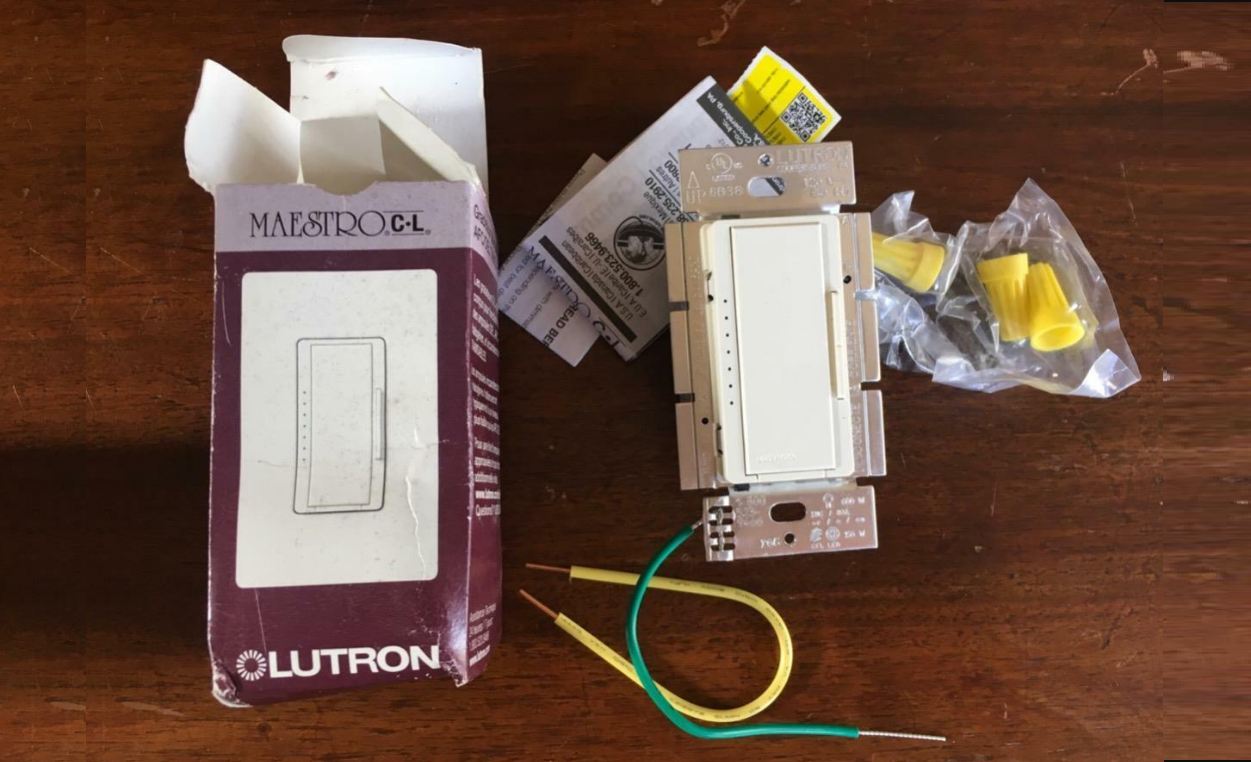
Content

Lutron Maestro Sensor Dimmer MSCL-OP153M
The Maestro Sensor Dimmer MSCL-OP153M is a cutting-edge home automation solution that offers homeowners the ability to conveniently and efficiently control their lights. With an estimated price range of $60 to $80 and a launching date of January 2021, this sensor dimmer is a must-have for anyone looking to upgrade their home's lighting system.
Detailed Specifications
The Maestro Sensor Dimmer MSCL-OP153M boasts several key features, including
- Sleek and modern design that blends seamlessly with any home decor
- Automatic on/off and dimming capabilities
- Adjustable fade rate and minimum light level settings
- Compatibility with LED, incandescent, and halogen bulbs
- Sensor range of up to 15 feet and 240-degree field of view
- Easy installation and setup process
- Optional occupancy and vacation mode settings
Overview
This document serves as a supplement to the Maestro® Occupancy/ Vacancy Sensor C•L® Dimmer instruction sheet.
Maestro® Sensor Dimmer
Indicator Lights (IL) 1–7
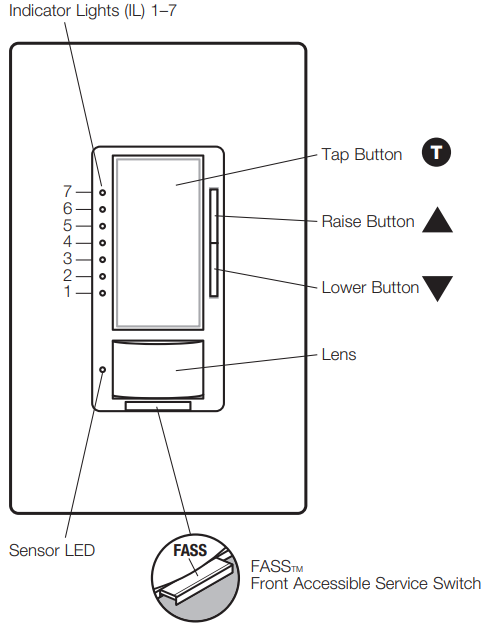
Notes
- To replace fixture bulb(s), power may be temporarily disconnected at the light fixture by pulling the FASSTM OUT on the dimmer.
- For any procedure other than routine bulb replacement, power MUST be disconnected at the main electrical panel.
Maestro Sensor Dimmer Coverage Area
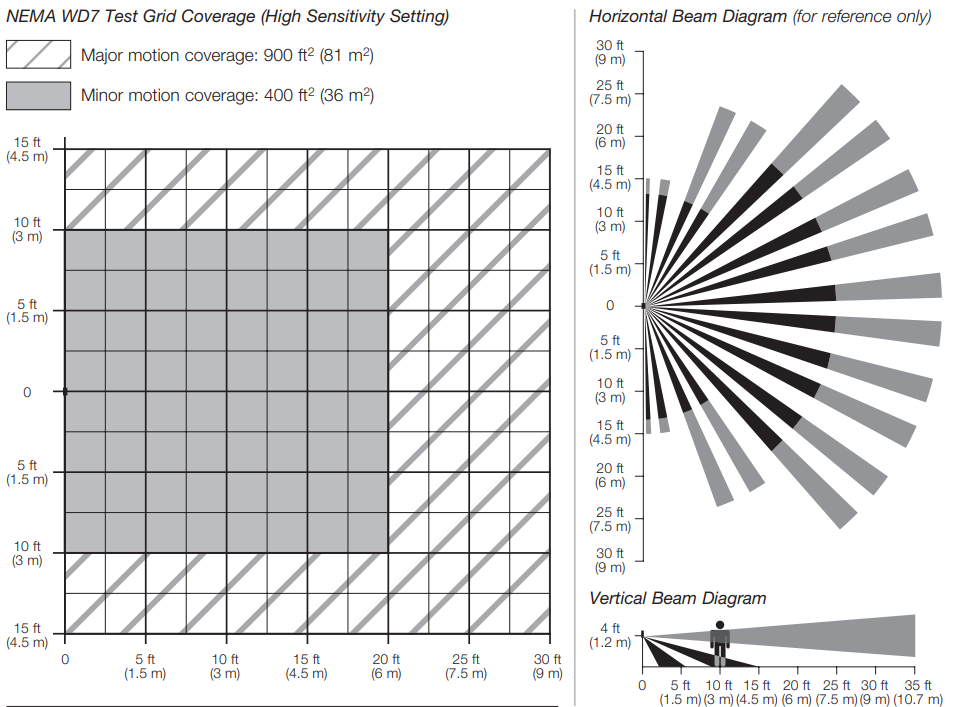
- Test Room Dimensions: 37 ft × 38 ft (11.28 m × 11.6 m)
- Test Floor Surface Material: Carpet
- Sensor Coverage Angle: 180°
- Major motion coverage: Initial trigger motion detection
- Minor motion coverage: Maintained motion detection
Features in Programming Mode
This Maestro Sensor Dimmer has features that allow you to customize the unit to achieve your individual needs. The following is an overview of these features
- Timeout
- Sensitivity
- Auto-ON
- Occupied Level
Timeout
The approximate time in minutes after which the lights will turn OFF after the last motion is detected. The default setting timeout is 5 minutes but can be adjusted to 1, 3, 15, or 30 minutes.
What Timeout Setting do I want?
Shorter timeouts are best in areas where occupants are generally moving around. Laundry rooms, foyers, kitchens, and closets are typically good applications for shorter timeouts. Longer timeouts are better for areas where occupants move less frequently, such as in an office. Using a timeout of 15 minutes or more may increase bulb life in fluorescent bulbs. Consider using a longer timeout if you are controlling a dimmable CFL.
- Sensitivity
The setting determines how sensitive the PIR sensor will be. Lowering the sensitivity will cause the Maestro® Sensor Dimmer to respond only to larger movements.- High Sensitivity: This is the most sensitive setting and will detect very slight motions. This is the recommended setting because it will work well for nearly all applications.
- Low Sensitivity: This is the least sensitive setting and can be used in areas of major or large motions.
- What Sensitivity Setting do I want?
High sensitivity is typically the best setting. If the Maestro® Sensor Dimmer is turning on too often due to unintended interference from the environment (e.g., heating or cooling vents near the Maestro® Sensor Dimmer, moving draperies), low sensitivity may be selected. - Auto-ON (Occupancy Version only)
The automatic functionality of the Maestro® Sensor Dimmer can be adjusted to control how the lights respond upon initial occupancy. There are four available Auto‑ON settings: Enabled, Disabled, Ambient Light Detect (ALD), and OFF‑While‑Occupied (OWO). The default setting is Enabled. - Auto-ON: Enabled: The lights will always turn ON when occupancy is detected.
When the user manually turns OFF the light, the light will remain OFF for 25 seconds. After this time, the Maestro® Sensor Dimmer will turn lights ON if motion is detected. - Auto-ON: Disabled: This setting converts the Maestro® Sensor Dimmer to Vacancy mode. The lights will not automatically turn ON but will still automatically turn OFF after vacancy. The lights must be manually turned ON by pressing the T button on the dimmer or switch.
- Auto-ON: Ambient Light Detect (ALD) Mode: The lights will turn ON when occupancy is detected and ambient light is too low. If lights turn ON when there is enough natural light, press the T button within 5 seconds of entering the room. If lights do not turn ON when there is not enough natural light, press the T button within 5 seconds of entering the room. Over time, this interaction will “teach” the Maestro® Sensor Dimmer your preferred setting.
- Auto-ON: OFF-While-Occupied (OWO) Mode: The lights will always turn ON when occupancy is detected. If lights are manually turned OFF, Maestro® Sensor Dimmer will keep lights OFF as long as room is occupied.
- What Auto-ON Setting do I want?
- If you want the lights to automatically turn ON when someone enters the room, the Auto‑ON setting should remain enabled.
- If you want the lights to turn ON automatically when someone enters the room, but also want the dimmer to keep the lights OFF after it has been manually turned OFF, you should select OFF‑While‑Occupied mode.
- If you want the lights to turn ON only when the
- T button is pressed, choose Auto‑ON: Disabled. This is Vacancy mode, and the unit will turn OFF automatically only when occupancy is no longer detected. Bedrooms are a typical application where the Auto‑ON feature should be Disabled.
- If you want the lights to remain OFF when there is already enough ambient light in the room, Ambient Light Detect mode should be Enabled to maximize energy savings. The user(s), upon entering the room, must be prepared to correct the dimmer with the
- T button if the lights do not respond as expected.
- Occupied Level
This setting determines how much light will be automatically turned ON when motion is detected. - Default Setting: 100%
- 100%: The lights will always turn on to 100% of the dimmable light level.
- 50%: The lights will always turn on to 50% of the dimmable light level.
- Preset: The lights will turn ON to the last level that was used on the Maestro® Sensor Dimmer. If you select a Locked Preset in Advanced Programming Mode, you will be able to lock this light level so that other adjustments will not change this preset
- What Occupied Level Setting do I want?
- Preset mode allows for full customization of the preferred light level.
- 100% will ensure that the lights are turned on to the brightest level available upon entering a room.
- 50% is the default light level for manual operation of Maestro® products. To synchronize the default setting levels of all Maestro® products in the house, this is the best choice.
Dimming Features in Advanced Programming Mode1
The Maestro® Sensor Dimmer has features that allow the user to change aspects of the dimming functionality. The features include:
Preset Light Level
- Set the light level that the lights turn ON to after a single press of the T button.
- Lock your preset to save your setting when using Occupied Level: Preset mode Manual Fade ON Time
- Set how quickly the lights will fade up to ON after a single press of the T button. Manual Fade OFF Time
- Set how quickly the lights will fade down to OFF after a single press of the T button. Delayed Fade to OFF 2
- Set to increase or decrease the delay of the Delayed Fade to OFF feature.
Enable/Disable NIghtlight Mode
- Set the Indicator LEDs to glow or stay OFF when the lights in the room are OFF. Low-End Trim3
- Set your minimum available light level during normal operation.
High-End Trim
- Set your maximum available light level during normal operation.
- Advanced Programming Mode instructions can be found on pages 8 –16.
- Delayed Fade to OFF Time instructions can be found on page 14.
- Raising the Low-End Trim on your dimmer may improve bulb performance for CFLs or LEDs.
Programming Mode
Enter Programming mode to change the settings on your Maestro® Sensor Dimmer. Note: Once a feature is modified, the setting is immediately saved.
Enter Programming Mode
(see picture at right)
- Pull the FASSTM toward you into the OFF position.
- Press
 and
and  hold the T button of the product you are programming.
hold the T button of the product you are programming. - Push the FASSTM away from you into the ON position while continuing to hold the T button for approximately 5 seconds until IL 1 blinks quickly.
- Continue programming: Go to Main Sensor Menu section below.
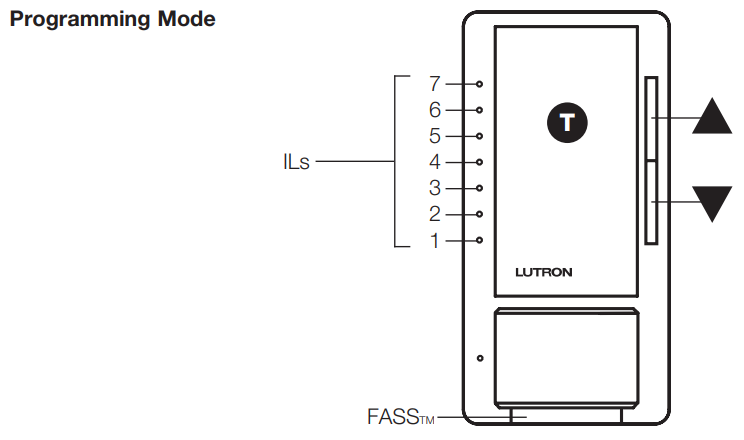
Note: If there is no activity for 1 minute, the Maestro® Sensor Dimmer will exit Programming mode automatically.
Main Sensor Menu
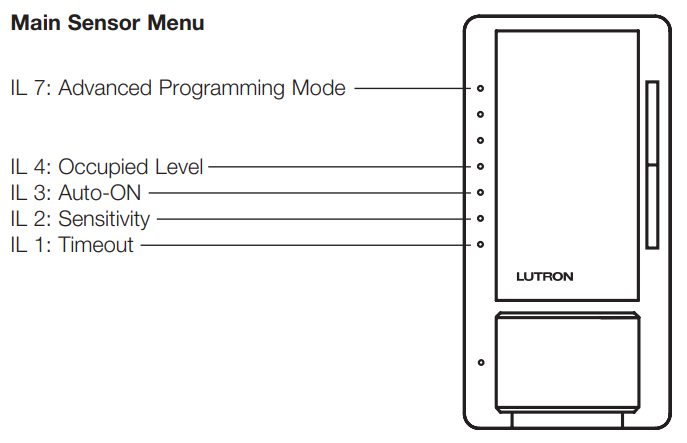
- Press the
 or
or  button to position the glowing IL next to the feature you want to modify:
button to position the glowing IL next to the feature you want to modify:- IL #7 . . . . . Advanced Programming Mode
- IL #4 . . . . . Occupied Level
- IL #3 . . . . . Auto-ON (occupancy version only)
- IL #2 . . . . . Sensitivity
- IL #1 . . . . . Timeout
- Press the T button one time to select that feature. |
- Go to the appropriate selection menu, starting below, to continue programming.
Selection Menu: Timeout
Once you've selected Timeout from the Main Sensor Menu, proceed with the following steps.

Test Mode is a temporary, short timeout (less than 15 seconds) that can be used to test the Maestro® Sensor Dimmer coverage. After entering Test Mode, the device will exit Test Mode automatically after 5 minutes, or when any button is pressed. If no motion is detected, the lights will turn OFF. If motion is detected, the lights will turn ON and continue to stay ON for as long as motion is detected. The sensor LED will flash when motion has been detected.
- Press the
 or
or button to move the blinking IL to the desired Timeout duration.
button to move the blinking IL to the desired Timeout duration. - Press the T button one time to set the Timeout duration and return to the Main Sensor Menu.
Default Setting: 5 minutes.
To Exit any mode or programming step
- Press and hold the T button for 5 seconds or
- Pull the FASSTM out, then push the FASSTM back in or
- Wait for 1 minute
Selection Menu: Sensitivity
Once you’ve selected Sensitivity from the Main Sensor Menu, proceed with the following steps.
In the Sensitivity Menu
- Press the
 or
or  button to move the blinking IL to desired sensitivity.
button to move the blinking IL to desired sensitivity. - Press the T button one time to set the Sensitivity level and return to the Main Sensor Menu.
Default Setting: High sensitivity.
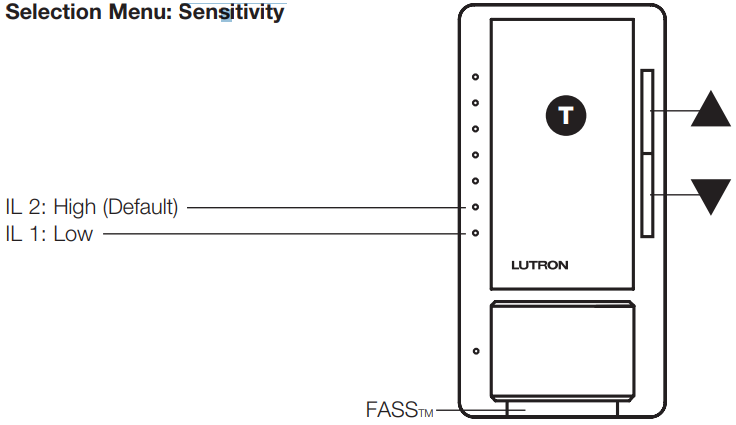
Selection Menu: Auto-ON
(Occupancy Version, MSCL-OP153M, Only) Once you’ve selected Auto-ON from the Main Sensor Menu, proceed with the following steps.
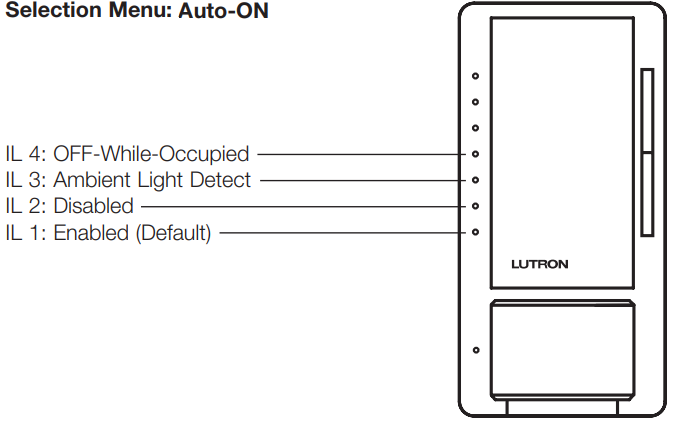
In the Auto-ON Menu
- Press the
 or
or  button to move the blinking IL to desired Auto-ON setting.
button to move the blinking IL to desired Auto-ON setting. - Press the T button one time to set the Auto-ON setting and return to the Main Sensor Menu. Default Setting: Auto-ON Enabled.
Selection Menu: Occupied Level
Once you’ve selected Occupied Level from the Main Sensor Menu, proceed with the following steps.
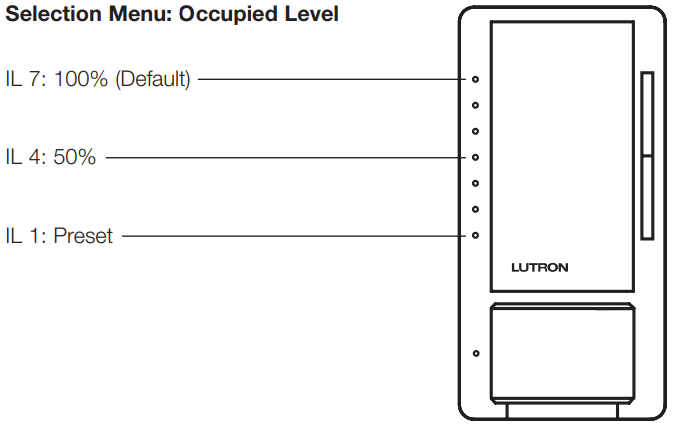
In the Occupied Level Menu
- Press the
 or
or  button to move the blinking IL to the desired Occupied Level.
button to move the blinking IL to the desired Occupied Level. - Press the T button one time to set the Occupied Level and return to the Main Sensor Menu.
Default Setting: 100%.
To Exit any mode or programming step
- Press and hold the T button for 5 seconds or
- Pull the FASSTM out, then push the FASSTM back in or
- Wait for 1 minute
Advanced Programming Mode
Enter Advanced Programming Mode (APM)
- While in Main Sensor menu, press the
 or
or  button until IL 7 is blinking.
button until IL 7 is blinking. - Press the T button one time to enter the APM menu.

Selection Menu: Advanced Programming Mode
- While in the APM menu, press the
 or
or button to position the slowly blinking IL next to the feature you want to modify.
button to position the slowly blinking IL next to the feature you want to modify. - Press the T button one time to select that feature for modification.
Go to the appropriate section starting on page 10 to continue programming.

Note: If there is no button activity for 1 minute, the dimmer will automatically exit APM and return to Normal Operation.
To Exit any mode or programming step
- Press and hold the T button for 5 seconds or
- Pull the FASSTM out, then push the FASSTM back in or
- Wait for 1 minute
Programming Option 1: Preset Light Level
- What it Does
Presets the dimmer to achieve a certain light level when the T button is pressed. If you prefer that the dimmer retains the same light level every time you turn it ON, choose the Locked Preset. If you prefer that the dimmer returns to the light level previously used when you turn it ON, choose the Unlocked Preset setting.
Note: Double-tapping the T button in Normal Operation mode will always bring the light level to maximum intensity. - Settings
There are two settings in Option 1: Preset Light Level. - Locked Preset
When programmed for a Locked Preset, the dimmer will always turn on to the predetermined locked level anytime the dimmer is turned on with a single tap of the T button. If you want occupancy detection to turn on your lights to this locked preset, set your Occupied Level to Preset per the instructions. - Unlocked Preset
When programmed for an Unlocked Preset, the dimmer will turn on to the light level to which it was previously adjusted. - Default Setting
Unlocked Preset (no ILs ON)
Locked Preset Directions
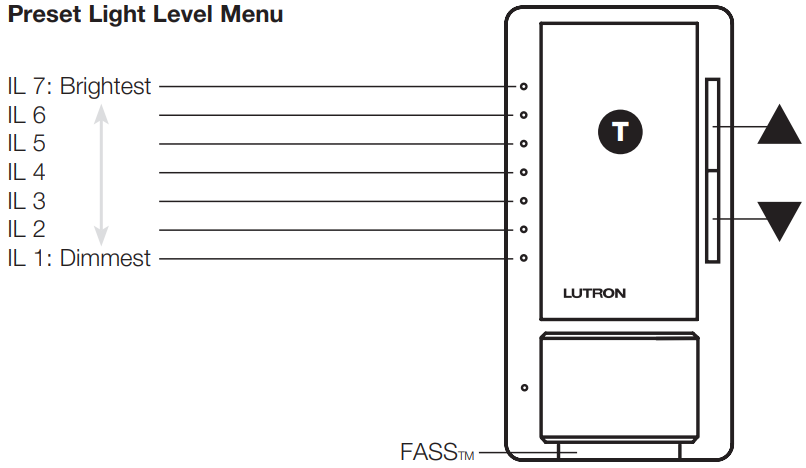
- Enter Preset Light Level Menu: While in APM, press the
 or
or  button to select the first option, Programming Option 1: Preset Light Level. Once IL 1 is blinking, press the T button; the IL will switch to the current setting and begin to blink rapidly or turn OFF.
button to select the first option, Programming Option 1: Preset Light Level. Once IL 1 is blinking, press the T button; the IL will switch to the current setting and begin to blink rapidly or turn OFF. - Select Desired Locked Preset Light Level: Press the or button to choose desired room light intensity. The room light will become brighter or dim, reflecting the Locked Preset level as the feature is adjusted.
- Press the T button one time to set the Preset Light Level and return to the APM main menu.
Note: If there is no button activity for 1 minute, the dimmer will automatically exit APM and return to Normal Operation.
To Exit any mode or programming step
- Press and hold the T button for 5 seconds or
- Pull the FASSTM out, then push the FASSTM back in or
- Wait for 1 minute
Preset Light Level
Unlocked Preset Directions
To deactivate a Locked Preset setting so that the dimmer will turn on to the light level to which it was last set while in Normal Operation, the Unlocked Preset must be activated.
- Enter Preset Light Level Menu: While in APM, press the
 or
or  button to select the first option, Programming
button to select the first option, Programming
Preset Light Level. Once IL 1 is blinking, press the T button; the IL will switch to the current setting and begin to blink rapidly or turn OFF. - Select Unlocked Preset: Press the button until IL 1 is quickly flashing. Release the button and press and hold the button again for approximately 3 seconds or until all ILs turn OFF.
Note: The light will remain at its minimum output when you perform this action. - Press the T button one time to set the Preset Light Level and return to the APM main menu.
Note: If there is no button activity for 1 minute, the dimmer will automatically exit APM and return to Normal Operation.
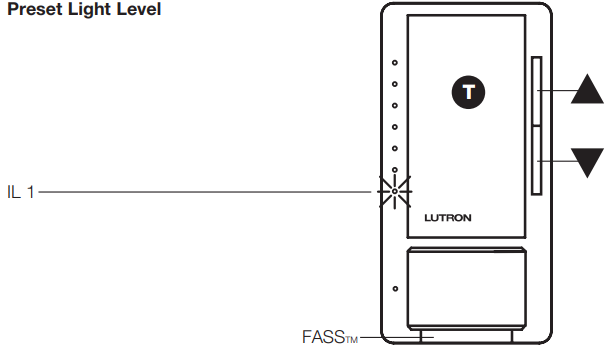
To Exit any mode or programming step
- Press and hold the T button for 5 seconds or
- Pull the FASSTM out, then push the FASSTM back in or
- Wait for 1 minute
Manual Fade ON Time
- What it Does
Controls how quickly the lights will fade up when the dimmer is manually turned ON. If the light controlled by the dimmer is the first or only light that will be turned ON in a particular room, most people prefer to use a faster time so that the room is immediately illuminated. Art lighting or other accent lighting is often more pleasing with a slower fade time. The Fade ON Time adjustment applies when the T button is pressed manually. All occupancy-based fade times are fixed. - Settings
The settings include fade times from OFF to Maximum Light Output in as quickly as 0.75 seconds and as slowly as 15 seconds. - Default Setting
0.75 seconds (IL 1)
Directions
- Enter Manual Fade ON Time Menu: While in APM, press the
 or
or button to select the second option, Programming Option 2: Manual Fade ON Time. Once IL2 is blinking, press the T button.
button to select the second option, Programming Option 2: Manual Fade ON Time. Once IL2 is blinking, press the T button. - Select Desired Manual Fade ON Time: Press the or button to select the desired Manual Fade ON Time. ILs 1–5 represent the different settings.
- Press the T button one time to set the Manual Fade ON Time and return to the APM main menu.
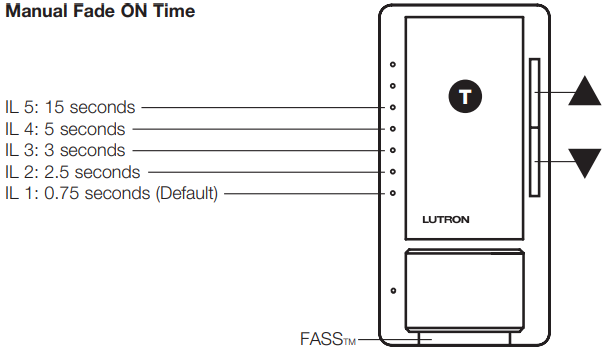
Notes
- The fade times while pressing either the or button during Normal Operation are not affected by any Manual Fade ON Time modification. These speeds are constant.
- The Manual Fade ON Times will be available only when the lights are turned ON using a Maestro® Sensor Dimmer or a Companion Dimmer; when using a mechanical switch in a 3-way application, the lights will fade ON and OFF at an accelerated rate.
- If there is no button activity for 1 minute, the dimmer will automatically exit APM and return to Normal Operation.
To Exit any mode or programming step
- Press and hold the T button for 5 seconds or
- Pull the FASSTM out, then push the FASSTM back in or
- Wait for 1 minute
Manual Fade OFF Time
- What it Does
Controls how quickly the lights will fade down when the dimmer is turned OFF. A slower Manual Fade OFF Time is suggested for rooms the user wishes to exit while the lights still provide illumination. Be aware that the light dimming may not be immediately noticeable for settings of 5 seconds or longer. The Fade OFF Time adjustment applies when the T button is pressedn manually. All occupancy-based fade times are fixed. - Settings
The settings include fade times from Maximum Light Output to OFF in as quickly as 0.75 seconds and as slowly as 15 seconds. - Default Setting
0.75 seconds (IL 1)
Directions
- Enter Manual Fade OFF Time Menu: While in APM, press the
 or
or  button to select the third option, Programming Option 3: Manual Fade OFF Time. Once IL 3 is blinking, press the T button.
button to select the third option, Programming Option 3: Manual Fade OFF Time. Once IL 3 is blinking, press the T button. - Select Desired Manual Fade OFF Time: Press the or button to select the desired Manual Fade OFF Time. ILs 1–5 represent the different settings.
- Press the T button one time to set the Manual Fade OFF Time and return to the APM main menu.

Notes
- The fade times while pressing the or button during Normal Operation are not affected by any Manual Fade OFF Time modification. These speeds are constant.
- The Manual Fade OFF Times will be available only when the lights are turned ON using a Maestro® Sensor Dimmer or a Companion Dimmer. While using a mechanical switch in a 3-way application, the lights will fade ON and OFF at an accelerated rate.
- If there is no button activity for 1 minute, the dimmer will automatically exit APM and return to Normal Operation.
Delayed Fade to OFF Time
- What it Does
Controls how quickly/slowly the room lights start the dimming sequence after the T button is pressed. Longer Fade to OFF Times are suggested for use in large rooms where the light control is opposite the exit and immediate dimming is not wanted. - Settings
The settings included in the dimming sequence are from the time that the T button is pressed (Normal Operation) until the room lights begin the Fade to OFF process. - Default Setting
30 seconds (IL 3)
Directions
- Enter Delayed Fade to OFF Time Menu: While in APM, press the
 or
or button to select the fourth option, Programming Option 4: Delayed Fade to OFF Time. Once IL 4 is blinking, press the T button.
button to select the fourth option, Programming Option 4: Delayed Fade to OFF Time. Once IL 4 is blinking, press the T button. - Select Desired Delayed Fade to OFF Time: Press the or button to select the desired Delayed Fade to OFF Time. ILs 1–7 represent the different settings.
- Press the T button one time to set the Delayed Fade to OFF Time and return to the APM main menu.
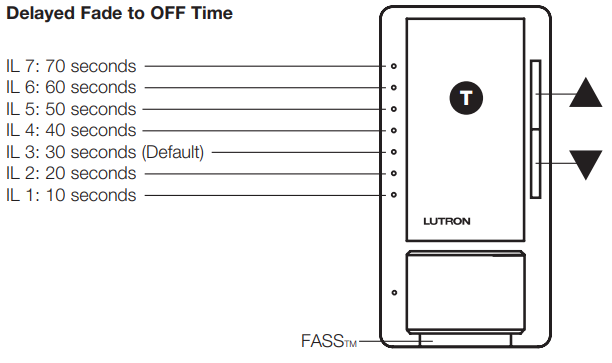
Notes
- To initiate the Delayed Fade to OFF feature in Normal Operation, while the light is ON, press and hold the T button for one second and then release.
- If there is no button activity for 1 minute, the dimmer will automatically exit APM and return to Normal Operation.
Nightlight Mode
- What it Doe
When the Maestro® Sensor Dimmer is turned OFF and the light goes out, the ILs remain ON in a dim glow state, known as Nightlight mode. Disabling Nightlight mode is an energy-saving practice and also allows the dimmer to be compatible with a broader range of CFLs and LEDs. Enabling Nightlight mode provides a soft glow for easy location of the dimmer in a dark room. - Settings
Enable Nightlight Mode: ILs will glow when Maestro® Sensor Dimmer is OFF. Disable Nightlight Mode: ILs will stay OFF when Nightlight Mode is OFF. - Default Setting
Nightlight Mode Enabled
Directions
- Enter Enable/Disable Nightlight Mode Menu: While in APM, press the
 or
or button to select the fifth option, Programming Option 5: Enable/Disable Nightlight Mode. Once IL 5 is blinking, press the T button.
button to select the fifth option, Programming Option 5: Enable/Disable Nightlight Mode. Once IL 5 is blinking, press the T button. - Select Enable/Disable Nightlight: Once in the menu, IL 4 will begin blinking rapidly. This indicates that Nightlight Mode is Enabled. Tapping the button will cause the IL to stop blinking. No ILs blinking indicates that Nightlight Mode is Disabled. To enable Nightlight Mode, tap the button so that IL 4 resumes rapid blinking.
- Press the T button one time to set the Enable/Disable Nightlight Mode and return to the APM main menu.
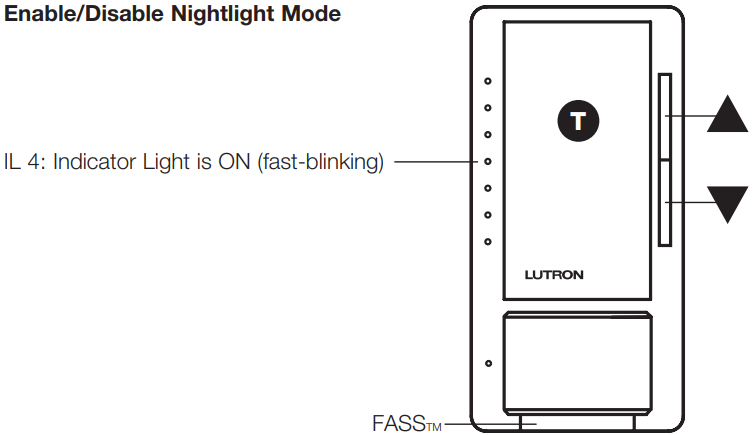
Notes
- It may be necessary to disable the ILs (Nightlight mode) when using certain CFL and LED bulbs to achieve best bulb performance.
- If there is no button activity for 1 minute, the dimmer will automatically exit APM and return to Normal Operation.
Low-End Trim (See Low-End Trim Shortcut below)
- What it Does
Eliminates LED and CFL bulb flickering and strobing when the dimmer is turned ON to the dimmest setting. This feature can also be used to set a personal preference for incandescent or halogen bulbs. - Settings
Some LED and CFL bulbs require a higher Low-End Trim than others. Low-End Trim allows the user to change the lowest dimmer light level based on bulb performance. Low-End Trim adjustment is required for LEDs and CFLs to optimize bulb performance and preserve bulb life. - Default Setting
IL 3
Directions (How to Program from APM)
- Enter Low-End Trim Menu: While in APM, press the
 or
or  button to select the sixth option, Programming Option 6: Low‑End Trim. Once IL 6 is blinking, press the T button.
button to select the sixth option, Programming Option 6: Low‑End Trim. Once IL 6 is blinking, press the T button. Select Desired Low-End Trim Level: Press the or button to select the desired Low-End Trim level. ILs 1–7represent the different settings.
Note
- While setting the Low-End Trim, observe the actual light (load) and not the ILs on the dimmer to determine the optimum setting.
- Incremental levels of light intensity exist within each
- IL setting, and the or button may have to be pressed several times to proceed to the next setting.
- Press the T button one time to set the Low-End Trim and return to the APM main menu.
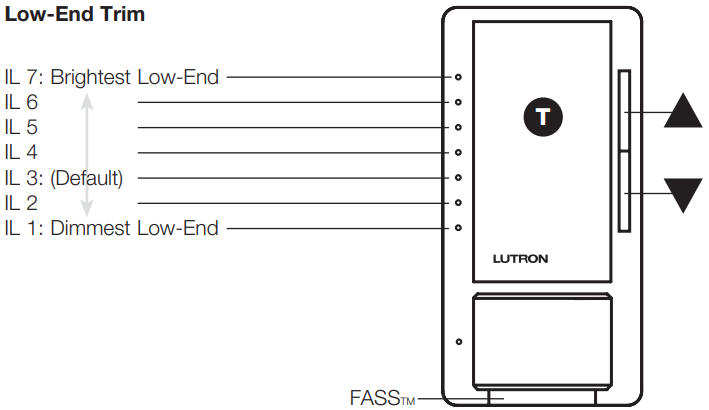
Notes:
- Low-end trim adjustment is required for LEDs and CFLs; if not performed, the life of the LED/CFL bulb may be reduced.
- If there is no button activity for 1 minute, the dimmer will automatically exit APM and return to Normal Operation.
Low-End Trim Shortcut
For quick changes* to the Low-End Trim, this shortcut method bypasses the APM.
- Press and hold the T and buttons until an IL blinks. The Load will turn OFF and then turn ON to Low-End.
- Press the
 or
or button to adjust light output until it’s stable and not flickering. Press and release the Tbutton to save setting.
button to adjust light output until it’s stable and not flickering. Press and release the Tbutton to save setting. - Press and release the T button to turn load OFF, then press the button once. If load does not turn ON or remains unstable, repeat Step 2, pressing the button to increase light level.
It’s not necessary to enter any Programming or APM modes.
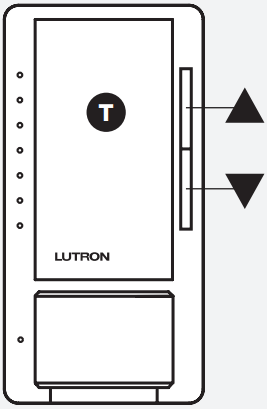
High-End Trim
- What it Does
Some lamps require a lower High-End Trim than others. This feature allows the user to determine the maximum light level and adjust the settings accordingly. Lowering the High-End Trim can help save energy. - Settings
High-End Trim allows the user to choose the brightest achievable light level. - Default Setting
IL 7: Brightest High-End
Directions
- Enter High-End Trim Menu: While in APM, press the or button to select the seventh option, Programming Option 7: High-End Trim. Once IL 7 is blinking, press the T button.
- Select Desired High-End Trim Level: Press the
 or
or  button to select the desired High-End Trim level. ILs 1–7 represent the different settings.
button to select the desired High-End Trim level. ILs 1–7 represent the different settings.
Note- While setting the High-End Trim, observe the actual light (load) and not the ILs on the dimmer to determine the optimum setting.
- Incremental levels of light intensity exist within each IL setting, and the or button may have to be pressed several times to proceed to the next setting.
- Press the T button one time to set the High-End Trim and return to the APM main menu.

Notes
- In some applications using LED and CFL bulbs, it may be necessary to lower the High-End Trim to achieve an optimum dimming range.
- If there is no button activity for 1 minute, the dimmer will automatically exit APM and return to Normal Operation.
Restoring Default Settings
Default settings
Programming Mode
- Timeout . . . . . . . . . . . . . . . . . . . . 5 minutes
- Sensitivity . . . . . . . . . . . . . . . . . . . High
- Auto On . . . . . . . . . . . . . . . . . . . . Enabled
- Occupied Level . . . . . . . . . . . . . . . . 100%
APM
- Preset Light Level . . . . . . . . . . . . . . . None selected
- Manual Fade to ON time . . . . . . . . . . . 0.75 seconds
- Manual Fade to OFF time . . . . . . . . . . . 2.5 seconds
- Delayed Fade to OFF time . . . . . . . . . . 30 seconds
- Nightlight Mode . . . . . . . . . . . . . . . . Enabled
- Low-End Trim . . . . . . . . . . . . . . . . . IL3
- High-End Trim . . . . . . . . . . . . . . . . . IL7: Brightest High-End
Restoring Default Settings
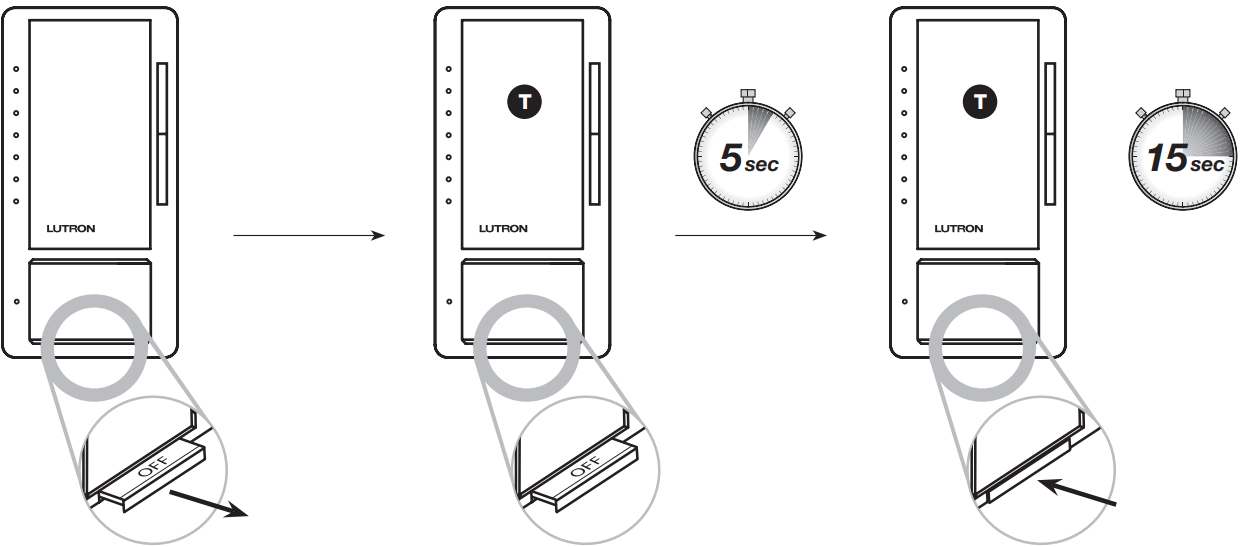
- Pull the FASSTM into the OFF position (Out); wait 5 seconds
- Press and hold the T button; continue to hold the T button and push the FASSTM back in to the ON Position; continue to hold the T button for approximately 15 seconds. Note: The dimmer will enter APM after the first 5 seconds; continue to hold the T button for the remaining 10 seconds until the lights in the room turn OFF and back ON.
- Load (light) will turn OFF and turn back ON to full intensity. This action represents a successful reset.
Note: If you perform the reset sequence, you will return your APM settings to their defaults; you may need to adjust Low-End Trim settings to accommodate your particular bulbs.
Two-Location Applications Using an Existing Switch
Settings
An existing 3-way mechanical switch may be used as a second-location control to activate lighting load from either location after a simple rewire. Additional programming is required to work with a mechanical switch and can be found on page 20. If using Companion Dimmer(s) for a 3-way application, additional programming is not required.
Wiring Prerequisites: 3-Way Wiring (Using 3-Way Mechanical Switch)
Note: Diagrams are for reference only. Refer to instruction sheet for proper wiring procedures.
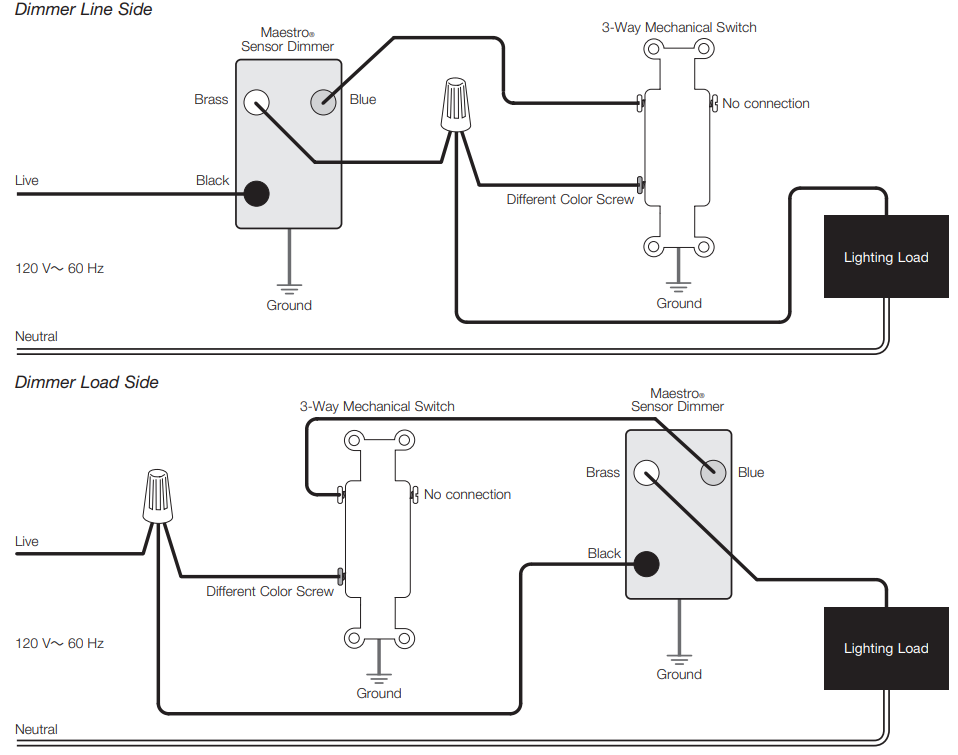
Notes
- Rewiring of existing switch is required; consult the instruction sheet for installation procedures.
- If switch is not rewired, it may result in abnormal behavior; consult your instruction sheet for wiring procedure.
- If the existing mechanical switch was rewired but the Two-Location Applications Using an Existing Switch setting is not changed to select the appropriate second location device, the Maestro® Sensor Dimmer may react abnormally. To resolve, change this setting to the appropriate device.
Selecting Two-Location Application Shortcut
Default Setting
Companion Dimmer (IL 4)
Directions
This feature is accessible only through the shortcut and cannot be entered via the APM menu.
- Enter 3-way Programming Menu: Press
 and
and  hold the T button and the button until an IL blinks.
hold the T button and the button until an IL blinks. - Select Desired Device: Press the
 or
or  button to select an option:
button to select an option:- IL 1: Mechanical Switc
- IL 4: Companion Dimmer
- Press the T button one time to set the option and return to the APM main menu.

Notes
- Rewiring of existing switch is required; consult your instruction sheet for installation procedures.
- If switch is not rewired, it may result in abnormal behavior; consult the instruction sheet for wiring procedure.
- If the existing mechanical switch was rewired but the
Maestro® Sensor Dimmer was not reprogrammed to accommodate this switch, perform steps 1 and 2 above, and select
Mechanical Switch (IL 1).
Description of Lutron Maestro Sensor Dimmer
The Lutron Maestro Sensor Dimmer is a versatile and advanced home automation solution that allows homeowners to control their lighting with ease. With its automatic on/off and dimming capabilities, this sensor dimmer provides a convenient and energy-efficient way to light up any room. The adjustable fade rate and minimum light level settings ensure that the lighting is always perfect for any occasion, while the compatibility with various bulb types makes it a universal solution for any home. The sensor has a range of up to 15 feet and a 240-degree field of view, providing reliable and accurate motion detection. The easy installation and setup process makes it a breeze to get started, while the optional occupancy and vacation mode settings provide added security and convenience.
Troubleshooting
| Symptom | Possible Cause | Probable Solution |
| After installation or following a power failure, the lights will turn ON suddenly after the lights have beenmanually turned OFF. | The sensor takes up to 2 minutes to perform a calibration following a power cycle. If the lights are OFF and the calibration completes while the space is occupied, the lights will turn ON. | Wait at least 2 minutes forcalibration to complete. Refer to the instructions. |
Change Occupied Level to Preset. This will cause occupancy detection to turn your unit ON to the last light level.It is less likely that you will notice this issue if you have selected this setting. | ||
| After installation or after replacing the bulbs, the lights may not turn ON when turning ON the lights manually or when the space is occupied. | The Low‑End Trims etting may haveto be adjusted. | Adjust the low-end trim from either the Shortcut menu or from the APM menu. Refer to instructions to change custom settings. |
| Thebulbs may not be on the approved bulb list. | Use bulbs that have been approved. Find the approved list for this product at www.lutron.com/dimcflled | |
| After installation or after replacing the bulbs,the lights may flash when turning ON the lights manually or when the space is occupied. | The Low‑End Trimsetting may haveto be adjusted. | Adjust the low-end trim from either the Shortcut menu or from the APM menu. Refer to instructions to change custom settings. |
| Thebulbs may not be on the approved bulb list. | Use bulbsthat have beenapproved. Find the approved list for this product at www.lutron.com/dimcflled | |
| After installation or after replacing the bulbs, the ILs may cycle,making the dimmer appear to reset. During this time, the lights may not turn ON or the lights may flash. | The Low‑End Trimsetting may haveto be adjusted. | Adjust the Low‑End Trim in the APM menu. Note: In this scenario, the low-end trim cannot be adjusted from the Shortcut menu. Refer to instructions to change custom settings. |
| Thebulbs may not be on the approved bulb list. | Use bulbs that have beenapproved. Find the approved list for this product at www.lutron.com/dimcflled | |
| 3-way switchdoes not turn the lights ON. | Multi-location/3-way wiringmay be incorrect. | Refer to wiring diagrams in instructions. |
| The Multi‑Location mode is set for Companion Dimmer. | Change the Two‑Location Application mode to Mechanical Switch. Refer to instructions to change custom settings. | |
| 3-way switch may havea locator light. | Replace the 3-way switch with one that doesn’t have a locator light. | |
| After installation,IL3will start blinking, then IL 2, etc. | A Mechanical switch is wired to the blue wire but the accessory mode is set to CompanionDimmer. This causes the dimmer to thinkthe toggle button is being held and will activatethe Delayed Fade To OFF feature. | Change the Two‑Location Application mode to Mechanical Switch. Refer to instructions to change custom settings. |
Lights do not turnON when spaceis occupied. | Sensor mode is set to Manual‑ON (Vacancy mode). | Refer to instructions to change custom settings. |
| Sensor mode is set to Auto‑ONDaylight Sensing (ALD)and the lightlevel in the room is too bright. | Turn the lights ON within 5 seconds upon entering the room to change the daylight threshold. | |
| Sensor does not havefull view of room. | Move objects blocking the sensor’s line-of-sight. | |
| Sensor mode is set to OFF‑While‑Occupied (OWO) mode, and the unit was recently manually turned OFF. | Refer to instructions to change custom settings, exit room andwait for sensorto timeout, or manually turn light back ON with T button. | |
| Multi-location/3-way wiring may be incorrect. | Refer to wiring diagrams in instructions.Wiring of a 3-way mechanical switch with this product is different from traditional 3-way wiring. |
| Symptom | Possible Cause | Probable Solution |
| Lights turnback ON after they are manually turned OFF. | Sensor mode is set to Auto ON: Enabled (Occupancy mode). The lights will continue to turn back on 25 seconds after the lights are manually turned OFF if the space is still occupied. | Change the Sensormode to Auto ON: Disabled (Vacancymode) or OFF‑While‑Occupied (OWO) mode. Refer to instructions to change custom settings. |
| Lights turn OFF while the space is still occupied. | Sensor’s timeout is tooshort for this application. | Increase timeout (e.g., 5 minutes to 30 minutes). |
| Sensor does not havefull view of room. | Move objects blocking the sensor’s line-of-sight. | |
| Sensor’s sensitivity is set too low. | Change sensitivity to High. | |
| Lights stay ON after space is vacated. | Sensor’s timeout has not yet expired. | Wait for the timeout to expire. |
| Motion is being detected from an external noise source such as an HVAC vent. | Change the sensitivity to Low. Try to eliminate the external noise source. | |
| Lights turn ON when walking past room. | Sensor coverage extends beyond room perimeter. | Change sensitivity to Low. Blockpart of the lens. |
| Reflections off shiny objects can allow the sensor to see outside the typical coverage. | Change sensitivity to Low. Blockpart of the lens. | |
Lights turn ON in Vacancy mode. | Lights canturn ON in the15 second “grace period” following timeout. | If Time outis set to 1 minute,wait for 1 minute 30 seconds before entering room again to verify that lights don’t turn back ON. |
Sensor mode may be set to something otherthan Manual‑ON (Vacancy mode). | Refer to instructions to change custom settings. | |
| Turning the lights ON with a 3-ways witch caused the lights to flash. | If thesensor detects occupancy just prior to turning the lights ON from the 3-way switch, the lights will turn ON and the 3-way switch will turn the lights OFF. | Set the Sensormode to Auto ON: Disabled (Vacancy mode). Refer to instructions to change custom settings. |
Following a power cycle, the lights the maximumturn ON to the full dim level, but the ILs are OFF. | If the Maestro® Sensor Dimmeris connected to agenerator, the dimmermay go intoa different operating mode. | Press the Toggle buttonto resume Normal Operation. |
| When turning the lights ON to themaximum dim level, the light dim level may go to high-end and then drop to a lower dim level. | The dimmer has an internal protection mechanism that will reduce the dim levelif the maximum maximumevel causes the dimmer to function incorrectly. | Adjust the High‑End Trim from the APM menu. Refer to instructions to change custom settings. |
| The bulbs may not be on the approved bulb list. | Use bulbsthat are on the approved list. Find the approved list for this product at www.lutron.com/dimcflled | |
| The sensorIL does not work. | The sensorIL will not glow to acknowledge motion if the lights are OFF. | Make sure the load is ON, and wave to confirm that the sensor IL is operational. |
Pros & Cons of Lutron MSCL-OP153M
Pros
- Sleek and modern design
- Automatic on/off and dimming capabilities
- Compatibility with various bulb types
- Adjustable fade rate and minimum light level settings
- Reliable and accurate motion detection
Cons
- May not be compatible with all home automation systems
- Higher price point compared to traditional dimmers
Customer Reviews of Lutron Maestro Sensor Dimmer
Customers love the Maestro Sensor Dimmer MSCL-OP153M for its sleek design, easy installation, and convenient automation capabilities. The motion detection sensor is highly accurate and reliable, and the adjustable fade rate and minimum light level settings are a hit among users. However, some customers have noted that it may not be compatible with all home automation systems, and the higher price point compared to traditional dimmers may be a drawback for some.
Most Common Complaints
The most common complaints about the Lutron Maestro Sensor Dimmer MSCL-OP153M are related to compatibility issues with certain home automation systems and the higher price point compared to traditional dimmers.
Faqs
Is installing the Lutron Maestro Sensor Dimmer in a bathroom appropriate?
How can I reset the Lutron Maestro Sensor Dimmer to its factory settings?
Can you save money on your electricity bills by using the Lutron Maestro Sensor Dimmer?
To what extent is the Lutron Maestro Sensor Dimmer easy to use?
What procedures must be followed in order to install the Lutron Maestro Sensor Dimmer?
Where can I buy the MSCL-OP153M Lutron Maestro Sensor Dimmer?
With the Lutron Maestro Sensor Dimmer, what kinds of lighting can you control?
Is it possible to alter the Lutron Maestro Sensor Dimmer's settings to suit my unique lighting requirements?
What is the integration process of the Lutron Maestro Sensor Dimmer with smart home systems?
What kind of warranty does the Lutron Maestro Sensor Dimmer come with?
Leave a Comment
